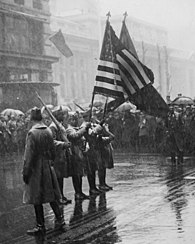
Francisco "Pancho" Villa was a general in the Mexican Revolution. He was a key figure in the revolutionary movement that forced out President Porfirio Díaz and brought Francisco I. Madero to power in 1911. When Madero was ousted by a coup led by General Victoriano Huerta in February 1913, he joined the anti-Huerta forces in the Constitutionalist Army led by Venustiano Carranza. After the defeat and exile of Huerta in July 1914, Villa broke with Carranza. Villa dominated the meeting of revolutionary generals that excluded Carranza and helped create a coalition government. Emiliano Zapata and Villa became formal allies in this period. Like Zapata, Villa was strongly in favor of land reform, but did not implement it when he had power. At the height of his power and popularity in late 1914 and early 1915, the U.S. considered recognizing Villa as Mexico's legitimate authority.
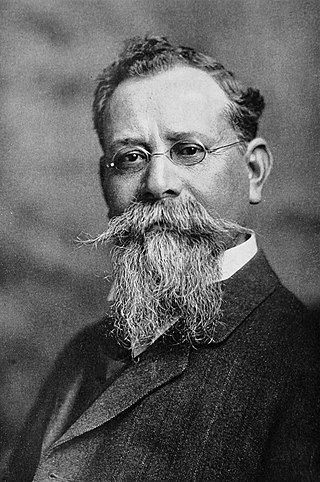
José Venustiano Carranza de la Garza was a Mexican land owner and liberal politician who served as President of Mexico from 1917 until his assassination in 1920, during the Mexican Revolution. He was previously Mexico's de facto head of state as Primer Jefe of the Constitutionalist faction from 1914 to 1917, and previously served as a senator and governor for Coahuila. He played the leading role in drafting the Constitution of 1917 and maintained Mexican neutrality in World War I.

The Pancho Villa Expedition—now known officially in the United States as the Mexican Expedition, but originally referred to as the "Punitive Expedition, U.S. Army"—was a military operation conducted by the United States Army against the paramilitary forces of Mexican revolutionary Francisco "Pancho" Villa from March 14, 1916, to February 7, 1917, during the Mexican Revolution of 1910–1920.

The United States involvement in the Mexican Revolution was varied and seemingly contradictory, first supporting and then repudiating Mexican regimes during the period 1910–1920. For both economic and political reasons, the U.S. government generally supported those who occupied the seats of power, but could withhold official recognition. The U.S. supported the regime of Porfirio Díaz after initially withholding recognition since he came to power by coup. In 1909, Díaz and U.S. President Taft met in Ciudad Juárez, across the border from El Paso, Texas. Prior to Woodrow Wilson's inauguration on March 4, 1913, the U.S. Government focused on just warning the Mexican military that decisive action from the U.S. military would take place if lives and property of U.S. nationals living in the country were endangered. President William Howard Taft sent more troops to the US-Mexico border but did not allow them to intervene directly in the conflict, a move which Congress opposed. Twice during the Revolution, the U.S. sent troops into Mexico, to occupy Veracruz in 1914 and to northern Mexico in 1916 in a failed attempt to capture Pancho Villa. U.S. foreign policy toward Latin America was to assume the region was the sphere of influence of the U.S., articulated in the Monroe Doctrine. However the U.S. role in the Mexican Revolution has been exaggerated. It did not directly intervene in the Mexican Revolution in a sustained manner.

The Apache Scouts were part of the United States Army Indian Scouts. Most of their service was during the Apache Wars, between 1849 and 1886, though the last scout retired in 1947. The Apache scouts were the eyes and ears of the United States military and sometimes the cultural translators for the various Apache bands and the Americans. Apache scouts also served in the Navajo War, the Yavapai War, the Mexican Border War and they saw stateside duty during World War II. There has been a great deal written about Apache scouts, both as part of United States Army reports from the field and more colorful accounts written after the events by non-Apaches in newspapers and books. Men such as Al Sieber and Tom Horn were sometimes the commanding officers of small groups of Apache Scouts. As was the custom in the United States military, scouts were generally enlisted with Anglo nicknames or single names. Many Apache Scouts received citations for bravery.

José Inés Salazar was a Mexican revolutionary general who led the Orozquistas during the Mexican Revolution and later fought with Pancho Villa. He was a native of Casas Grandes, Chihuahua.
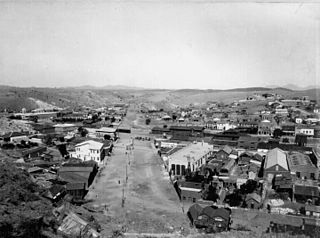
The Battle of Ambos Nogales, or as it is known in Mexico La batalla del 27 de agosto, was an engagement fought on 27 August 1918 between Mexican military and civilian militia forces and elements of U.S. Army troops of the 35th Infantry Regiment, who were reinforced by the Buffalo Soldiers of the 10th Cavalry Regiment, and commanded by Lt. Col. Frederick J. Herman. The American soldiers and militia forces were stationed in Nogales, Arizona, and the Mexican soldiers and armed Mexican militia were in Nogales, Sonora. This battle was notable for being a significant confrontation between U.S. and Mexican forces during the Border War, which took place in the context of the Mexican Revolution and the First World War.

The Battle of Columbus, March 9, 1916, began as a raid conducted by remnants of Pancho Villa's Division of the North on the small United States border town of Columbus, New Mexico, located 3 miles (4.8 km) north of the border with Mexico. The raid escalated into a full-scale battle between Villistas and the United States Army.
Mexico was a neutral country in World War I, which lasted from 1914 to 1918. The war broke out in Europe in August 1914 as the Mexican Revolution was in the midst of full-scale civil war between factions that had helped oust General Victoriano Huerta from the presidency earlier that year. The Constitutionalist Army of Venustiano Carranza under the generalship of Alvaro Obregón defeated the army of Pancho Villa in the Battle of Celaya in April 1915.

The Second Battle of Agua Prieta, 1 November 1915, was fought between the forces of Pancho Villa and those of the future President of Mexico, Plutarco Elías Calles, a supporter of Venustiano Carranza, at Agua Prieta, Sonora, as part of the Mexican Revolution. Villa's attack on the town was repulsed by Calles. The battle helped to establish Carranza's control over Mexico and directly led to his becoming, with United States recognition, president. Villa believed that Calles had received tactical and strategic support from the United States since the town is located across the border from Douglas, Arizona and launched his raid on Columbus, New Mexico partly as a reprisal.

General Jacinto Blas Treviño González was a Mexican military officer, noteworthy for his participation in the Mexican Revolution of 1910 to 1921.

The Mexican Border War, or the Border Campaign, refers to the military engagements which took place in the Mexican–American border region of North America during the Mexican Revolution. The period of the war encompassed World War I, and the German Empire attempted to have Mexico attack the United States, as well as engaging in hostilities against American forces there itself.

The Battle of Parral, on April 12, 1916, was the first battle between soldiers of Venustiano Carranza, known as Carrancistas, and the United States military during the Mexican Expedition. When a small force of American cavalry was leaving the city of Parral, in the Mexican state of Chihuahua, a superior force of Carrancista soldiers attacked which resulted in a bloody running engagement. Using a strategy of organized withdrawal, the Americans were able to repulse the Mexican attacks and safely escape to the fortified village of Santa Cruz de Villegas.

The Battle of Guerrero, or the Battle of San Geronimo, in March 1916, was the first military engagement between the rebels of Pancho Villa and the United States during the Mexican Expedition. After a long ride, elements of the American 7th Cavalry Regiment encountered a large force of Villistas at the town of Guerrero in the Mexican state of Chihuahua. In what has been called the "last true cavalry charge," the Americans assaulted the town and routed the defenders, inflicting over seventy-five casualties on the Mexicans with the loss of only five men wounded.
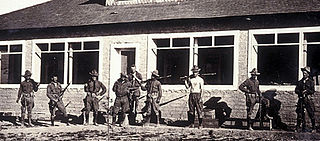
The raid on Glenn Springs occurred on the night of May 5–6, 1916, when Mexican Villistas and Carrancistas attacked the towns of Boquillas and Glenn Springs, Texas. In Glenn Springs, the raiders burned several buildings and fought a three-hour battle with a small force of American soldiers who were stationed there. At the same time, a second party of rebels robbed a general store and a silver mine in Boquillas. Four Americans were killed and the rebels took two hostages to Coahuila. In response to the attack, the United States Army launched a short punitive expedition into Mexico, fought with the rebels, and rescued the captives.

The Second Battle of Nogales was a three-sided military engagement of the Mexican Revolution, fought in November 1915 at the border towns of Nogales, Sonora, and Nogales, Arizona. On the morning of November 26, rebel forces of Pancho Villa, who occupied Nogales, Sonora, began firing on United States Army soldiers in Nogales, Arizona. The Americans responded with counter fire for over two hours before a force of Carrancistas arrived to attack the Villistas. Later that day, the Constitutionalistas accidentally opened fire on American soldiers and another short skirmish was fought. The battle resulted in the deaths of several Mexicans and was the first significant engagement fought between Villistas and the United States military.

The Third Battle of Ciudad Juarez, or simply the Battle of Juarez, was the final major battle involving the rebels of Francisco "Pancho" Villa. It began on June 15, 1919, when Villa attempted to capture the border city of Ciudad Juarez from the Mexican Army. During the engagement the Villistas provoked an intervention by the United States Army protecting the neighboring city of El Paso, Texas. The Americans routed the Villistas in what became the second largest battle of the Mexican Revolution involving the US, and the last battle of the Border War. With the American army closing in, the Villistas had no choice but to retreat. Pancho Villa then attacked Durango but lost again, so he retired to his home at Parral, Chihuahua in 1920, with a full pardon from the Carrancista government.
The Raid onSan Ygnacio refers to a battle fought on June 15, 1916 between the United States Army and Mexican raiders near the border town of San Ygnacio, Texas. Three different Mexican factions were known to have launched raids into Texas at the time but most of the evidence suggests that either Seditionists or Carrancistas were responsible for the incursion. Four American soldiers were killed during the battle, along with at least six of the raiders, and the resulting American punitive expedition further strained the already hostile relationship between the Mexican and United States governments.
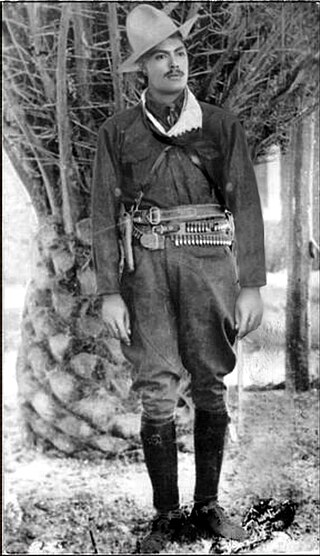
Félix Uresti Gómez was a Mexican revolutionary holding the rank of General and leading Mexican forces at Carrizal, Chihuahua on June 21, 1916.

Henry Rodney Adair (1882–1916) was an American cavalry officer. He is most notable for his participation in the Battle of Carrizal of the Pancho Villa Expedition.


















